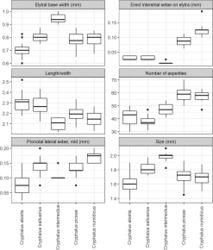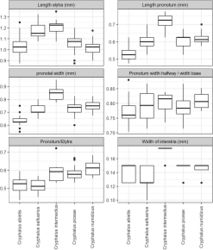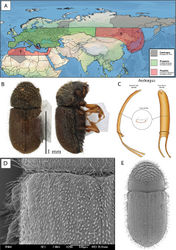Cryphalus piceae
| Notice: | This page is derived from the original publication listed below, whose author(s) should always be credited. Further contributors may edit and improve the content of this page and, consequently, need to be credited as well (see page history). Any assessment of factual correctness requires a careful review of the original article as well as of subsequent contributions.
If you are uncertain whether your planned contribution is correct or not, we suggest that you use the associated discussion page instead of editing the page directly. This page should be cited as follows (rationale):
Citation formats to copy and paste
BibTeX: @article{Justesen2023ZooKeys1179, RIS/ Endnote: TY - JOUR Wikipedia/ Citizendium: <ref name="Justesen2023ZooKeys1179">{{Citation See also the citation download page at the journal. |
Ordo: Coleoptera
Familia: Curculionidae
Genus: Cryphalus
Name
Cryphalus piceae (Ratzeburg, 1837) – Wikispecies link – Pensoft Profile
- Cryphalus orientalis Eggers, 1911b: 122 (syn: Pfeffer and Knížek 1993[1]).
- Cryphalus hattorii Kôno, 1938: 67 (syn: Inouye and Nobuchi 1957[2]).
- Cryphalus subdepressus Eggers, 1940d: 37 (syn: Wood 1992a[3]).
Type material
According to Wood (1967)[4] and Horn et al. (1990b)[5], Ratzeburg’s material was destroyed during WWII. The authors have confirmed that the material was not present at the listed museums in Horn et al. (1990B)[5], and it is therefore presumably destroyed.
Neotype designation
We designate a neotype of Cryphalus piceae with the express purpose of clarifying the taxonomic status. The original description was based on specimens collected either in Upper Silesia (Poland) or Bavaria (Germany) (Ratzeburg 1837[6]). A neotype of Cryphalus piceae (Ratzeburg, 1837) was designated (Fig. 9). It is a male collected 14/02-2018 in Austria (48°04'31.3"N, 15°21'31.6"E) from an Abies nordmanniana (Steven) Spach branch, not far from Bavaria. The specimen will be stored at NHMD in the entomological collections. COI sequence (Fig. 8; A.7 Hummelbach) is from a specimen collected in the same branch as the neotype.
Material examined
474 specimens from various locations in Europe (Table 1) were examined. Morphological measurements were made on 33 specimens from Austria (7), Germany (12) and Hungary (14). The average results are shown in Fig. 2.
Diagnosis
This species can be diagnosed from morphologically similar Cryphalus in Europe by the combination of a circular pronotum that is anteriorly constricted, asperities (> 50) on pronotum in almost concentric circles, long erect interstrial setae on the elytral declivity approximately same length or only slightly longer than width of second interstria. For confident identification the male genitalia is unique. The penis body when seen from above (dorsally) is equally broad and asymmetric, slightly spiralled. The entire aedeagus is ~ 0.6 mm in length (Fig. 10B–E).
Description
Length 1.45–1.93 mm, average size 1.73 mm (neotype 1.85 mm). Proportions 2.21× as long as wide, elytra 1.35× as long as wide, elytra 1.72× as long as pronotum. Antennae: club with three procurved sutures marked by coarse and long setae. Funiculus with four antennomeres (with pedicel). Pronotum: dark brown to black on both slope and disc. Profile anterior to summit rounded but slightly constricted anteriorly, wider in line with summit. Anterior margin with 4–8 asperities, the outer one or two pairs usually smaller; erect setae on entire lateral margin of pronotum. Anterior slope with > 50 asperities, including the ones on the anterior margin. Disc ~ 1/4 the length of pronotum, gently sloped, weakly tuberculate surface texture with small hair-like setae in each tubercule. Vestiture on pronotal declivity and disc hair-like. Suture between pronotum and elytra weakly sinuate. Scutellum: with trifurcate setae on the margin towards elytra (only visible at high magnification). Elytra: usually brown to black, if brown often darker at base, sometimes well-developed adults are light brown, elytral margins slightly wider 2/3 from base. Elytral declivity regularly rounded. Surface smooth. Striae with rows of punctures, each puncture with a short hair-like seta, punctures sometimes visible. Interstrial setae long (0.13–0.23 mm) and erect. Interstrial ground vestiture (scales) are serrated, ~ 2–3× as long as wide and translucent brown with a weak iridescence (Fig. 10B, D, E). Proventriculus: sutural teeth of irregular size, confused, in two or more longitudinal rows. Apical teeth extend laterally over the entire segment. Masticatory brush slightly < 1/2 of the proventricular length (Fig. 7). Proventriculus also illustrated in Escherich (1923)[7].
Sexual dimorphism. Males and females can be separated using the last ventrite (Fig. 11), as suggested by (Johnson et al. 2020a[8]). Wood (1982)[9] also suggests that the sexes of several scolytines including Cryphalus, can be separated by males having a clearly visible 8th tergite and the females a highly reduced or absent 8th tergite. This character was not examined. We observed some small external differences between males and females. The females (1.77 mm) were slightly larger than males (1.68 mm), and the interstrial setae were overall longer on the females (0.20 mm) compared to the males (0.16 mm). However, there were a considerable overlap between males and females. No clear difference in tubercles or carina on the frons was noticed. Male. The entire aedeagus is ~ 0.6 mm when measured vertically (i.e., from the two points furthest away from each other, Fig. 5). The penis body when seen from above (dorsally) is asymmetrical, evenly broad, and spiralled. Aedeagus apodemes makes up ~ 30% of the entire aedeagus length when measured vertically, they are spiralled and bending downwards. The tegmen is sclerotised and completes a ring around the penis body. It is thin and has two thin ventral apodemes, which are approximately the length of the distance between them (Figs 5, 10C).
Larvae. The larvae are described by Kalina (1970)[10].
Host plants
The main hosts of C. piceae are Abies Mill. and Picea Mill. (Escherich 1923[7]; Pfeffer 1995[11]; Wermelinger et al. 2002[12]). In a study on bark beetles which was designed to test their specificity on different conifer hosts, it was found that among Abies, Picea, Pinus L., and Cupressus L., C. piceae preferred Abies and Picea (Chararas et al. 1982[13]).
Distribution
Cryphalus piceae is found in Europe: Austria, Bosnia-Herzegovina, Bulgaria, Belarus, Croatia, Czechia, France, Germany, Greece, Hungary, Italy, Latvia, Lithuania, Macedonia, Montenegro, Poland, Romania, Slovakia, Slovenia, Spain, Switzerland, Ukraine, Russia: Central European territory, South European Territory. North Africa: Algeria. Asia: Japan, North Korea, South Korea, Turkey, Russia: Far East, China: North East Territory (Knížek 2011[14]; Alonso-Zarazaga et al. 2023[15]).
Cryphalus piceae has a more southerly distribution. Until now the northernmost record was Denmark (Justesen et al. 2020[16]), but it was recently collected in southern Sweden (Lindelöw and Jonsell 2022[17]). It is found in most of central and southern Europe where Picea and Abies are present. It has been mentioned from Algeria (Knížek 2011[14]), and possibly also Morocco (Benhalima et al. 2005[18]). However, the distribution of C. piceae may be confused with C. numidicus in North Africa and in the Mediterranean in general, because of the similar appearance of the two species. Wood (1992b)[19], Sarikaya and Avci (2011)[20] and Cilbircioğlu and Ünal (2012)[21] have mentioned C. piceae from Turkey and in the present study we barcoded individuals from Caucasus (Georgia) (Fig. 8). Further studies are needed to understand the distributional overlap and extent of both species. Similarly, the East Palearctic distribution of C. piceae is not sufficiently studied as was highlighted by our molecular data (Fig. 8). It is possible that C. piceae is present all the way across Russia and parts of China to Japan and Korea (Inouye and Nobuchi 1957[2]; Wood 1992b[19]), but this needs further clarification. As Abies is absent from the European part of Russia, the presence of C. piceae in this area, is dependent on reproduction in other conifer hosts. See Fig. 10A for distribution.
Bionomics
During the winter adult C. piceae hibernate individually on healthy trees, by excavating short tunnels into the phloem (Justesen et al. 2020[16]). Rarely do they also hibernate as larvae or pupae in dead trees or branches infested earlier in the season (Toper 2002[22]). The hibernating adults begin activity around mid/end of March, depending on temperatures (Justesen et al. 2020[16]). During March and April C. piceae aggregates on suitable material and mates. The preferred material is weakened parts of trees, or any smaller branches that have broken off during the winter season and are still relatively fresh. After mating they excavate a nuptial chamber, and the female lays 5–26 eggs (Cerchiarini and Tiberi 1997[23]; Toper 2002[22]). The development time from egg to adult depends on temperature. Most commonly, there are two generations a year plus a sister generation; however, in colder regions C. piceae only has one generation a year (Justesen et al. 2020[16]).
Economic significance
The harmful properties of C. piceae are discussed in detail in Justesen et al. (2020)[16], but most likely C. piceae only colonise very weak or recently dead trees. The low impact on host tree survival during colonisation was also confirmed by Justesen et al. (in press B). However, in areas where C. piceae reach very high population densities, their ability to penetrate and overwinter in healthy trees could potentially have negative impacts. This could be through lowered tree growth, as the overwintering beetles cause the tree to invest energy into excreting resin from the penetrations. Additionally, the movement from dead or dying trees to healthy trees, could potentially vector fungal diseases, thereby affecting host tree survival. However, the negative impacts of overwintering beetles remain to be explored (Justesen et al. 2020[16]).
Remarks
The shape and size of the aedeagus is the best character to ensure correct identification. The penis body when seen from above is asymmetric and slightly spiralled in C. piceae, and highly asymmetric and spiralled in C. numidicus. The entire aedeagus is slightly longer (0.6 mm) and broader in C. piceae compared to a shorter (0.5 mm) and thinner aedeagus in C. numidicus.
Both Grüne (1979)[24] and Noblecourt and Schott (2004)[25] mentioned that the pronotum is anteriorly constricted (dorsal view) (Grüne 1979[24]) or slightly narrowed in the front (Noblecourt and Schott 2004[25]) in C. piceae compared to the rounder pronotal shape of C. numidicus. In the original description of C. numidicus this character is also mentioned (Eichhoff 1878a[26]). This character was partly confirmed. The comparison between the width of pronotum at the widest compared to the width between apex and summit (Fig. 3), generally showed a more rounded shape in C. numidicus compared to C. piceae, but with a high degree of overlap.
Noblecourt and Schott (2004)[25] mentioned C. piceae with shorter setae on the lateral margins of pronotum and elytra compared to C. numidicus. During our examinations we also noticed these hair-like setae were shorter in C. piceae. Additionally, we found that the lengths of the interstrial hair-like setae on the elytral declivity are markedly shorter in C. piceae (0.13–0.23 mm) compared to C. numidicus (0.20–0.38 mm). The longer setae on elytra were also mentioned in the original description of C. numidicus (Eichhoff 1878a[26]).
Noblecourt and Schott (2004)[25] and Pfeffer (1995)[11] used size as a good separating character between C. piceae (1.1–1.6 mm) and C. numidicus (1.3–2 mm), whereas Grüne (1979)[24] measured C. piceae (1.1–1.8 mm) to be similar sized to C. numidicus (1.2–1.8 mm). The original description by Eichhoff found C. numidicus to be between 1.3 and 1.6 mm (Eichhoff 1878a[26]). Our measurements did not find a size difference between C. piceae (1.45–1.93 mm) and C. numidicus (1.50–1.88 mm), but the 16 measured C. numidicus specimens were all collected from the same tree.
Taxon Treatment
- Justesen, M; Hansen, A; Knížek, M; Lindelow, Å; Solodovnikov, A; Ravn, H; 2023: Taxonomic reappraisal of the European fauna of the bark beetle genus Cryphalus (Coleoptera, Curculionidae, Scolytinae) ZooKeys, 1179: 63-105. doi
Images
|
Other References
- ↑ Pfeffer A, Knížek M (1993) Scolytidae. 153–158. In: Jelínek J (Ed.) Check-list of Czechoslovak Insects IV (Coleoptera). Seznam československých brouků.Folia Heyrovskyana Supplementum1: 3–172.
- ↑ 2.0 2.1 Inouye M, Nobuchi A (1957) A revision of Cryphalus species injurious to coniferous trees from Hokkaido, Japan (Coleopt. Scolytidae).Bulletin of the Government Forest Experimental Station103: 45–56.
- ↑ Wood S (1992a) Nomenclatural changes in Scolytidae and Platypodidae (Coleoptera).The Great Basin Naturalist52(1): 89–92. https://www.jstor.org/stable/41712699 [Accessed 03 February 2023]
- ↑ Wood S (1967) Cryphalus Erichson, 1836 (Insecta, Coleoptera): Proposed Designation of a Type-Species under the Plenary Powers Z.N.(S.) 1788.Bulletin of Zoological Nomenclature24: 121–122.
- ↑ 5.0 5.1 Horn W, Kahle I, Friese G, Gaedike R (1990b) Collectiones Entomologicae, ein Kompendium über den Verbleib Entomologischer Sammlungen der Welt bis 1960. Teil II: L bis Z.Akademie der Landwirtschaftswissenschaften der Deutschen Demokratischen Republik, Berlin, Germany, 220 pp.
- ↑ Ratzeburg J (1837) Die Forst-Insecten oder Abbildung und Beschreibung der in den Wäldern Preussens und der Nachbarstaaten als schädlich oder nützlich bekannt gewordenen Insecten. Die Käfer Erster Theil. Nicolai, Berlin, [x + 4 +] 202 pp [21 pls].
- ↑ 7.0 7.1 Escherich K (1923) Die Forstinsekten Mitteleuropas (Vol. 2). Parey, Berlin, 342–380.
- ↑ Johnson A, Hulcr J, Knížek M, Atkinson T, Mandelshtam M, Smith S, Cognato A, Park S, Li Y, Jordal B (2020a) Revision of the bark beetle genera within the former Cryphalini (Curculionidae: Scolytinae).Insect Systematics and Diversity4(3): 1–1. https://doi.org/10.1093/isd/ixaa002
- ↑ Wood S (1982) The bark and ambrosia beetles of North and Central America (Coleoptera: Scolytidae), a taxonomic monograph.Memoirs of the Great Basin Naturalist6: 1–1359. https://www.biodiversitylibrary.org/part/248626 [Accessed 03 February 2023]
- ↑ Kalina V (1970) Contribution to the knowledge of the larvae of European bark beetles (Coleoptera, Scolytidae).Acta Entomologica Bohemoslovaca67: 116–132.
- ↑ 11.0 11.1 Pfeffer A (1995) Zentral- und Westpaläarktische Borken- und Kernkäfer (Coleoptera: Scolytidae, Platypodidae).Pro Entomologia, Basel, 310 pp.
- ↑ Wermelinger B, Duelli P, Obrist M (2002) Dynamics of saproxylic beetles (Coleoptera) in windthrow areas in alpine spruce forests. Forest Snow and Landscape Research 77(1/2): 133–148.
- ↑ Chararas C, Revolon C, Feinberg M, Ducauze C (1982) Preference of certain Scolytidae for different conifers.Journal of Chemical Ecology8(8): 1093–1109. https://doi.org/10.1007/BF00986980
- ↑ 14.0 14.1 Knížek M (2011) Scolytinae. In: Löbl I Smetana A (Eds) Catalogue of Palaearctic Coleoptera (Vol.7), Curculionoidea I. Apollo Books, Steenstrup, 86–87. [204–251]
- ↑ Alonso-Zarazaga M, Barrios H, Borovec R, Bouchard P, Caldara R, Colonnelli E, Gültekin L, Hlaváč P, Korotyaev B, Lyal C, Machado A, Meregalli M, Pierotti H, Ren L, Sánchez-Ruiz M, Sforzi A, Silfverberg H, Skuhrovec J, Trýzna M, Velázquez de Castro A, Yunakov N (2023) Cooperative catalogue of Palaearctic ColeopteraCurculionoidea. Monografias Electrónicas, Sociedad Entomológica Aragonesa 14: e780.
- ↑ 16.0 16.1 16.2 16.3 16.4 16.5 Justesen M, Hansen A, Thomsen I, Byriel D, Ro-Poulsen H, Ravn H (2020) Contributions to the knowledge on biology and phenology of Cryphalus piceae (Coleoptera: Curculionidae: Scolytinae).Scandinavian Journal of Forest Research35(8): 468–475. https://doi.org/10.1080/02827581.2020.1797868
- ↑ Lindelöw Å, Jonsell M (2022) Svenska skalbaggar 2 – nya barkborrar (Coleoptera: Curculionidae: Scolytinae) för landet och arter på spridning.Entomologisk Tidskrift143(3): 93–108.
- ↑ Benhalima S, Sauvard D, Villemant C, Mouna M, Lieutier F (2005) Life cycle of three xylophagous species (Coleoptera: Scolytidae) that cause damage to Atlas cedar (Cedrus libani atlantica) in the Middle Atlas (Morocco). In: Entomological Research in Mediterranean Forest Ecosystems. Science update, QUAE publishers, INRA editions, 169–176.
- ↑ 19.0 19.1 Wood S (1992b) A Catalog of Scolytidae and Platypodidae (Coleoptera), Part 2: Taxonomic Index. Volume B. Great Basin naturalist memoirs 13: 1553. https://www.biodiversitylibrary.org/page/8897072 [Accessed 03-02-2023]
- ↑ Sarikaya O, Avci M (2011) Bark beetle fauna (Coleoptera: Scolytinae) of the coniferous forests in the Mediterranean region of Western Turkey, with a new record for Turkish fauna.Turkish Journal of Zoology35(1): 33–47. https://doi.org/10.3906/zoo-0901-8
- ↑ Cilbircioğlu C, Ünal S (2012) Bark beetles and their natural enemies on oriental spruce from the black sea region of Turkey.Journal of Agricultural and Urban Entomology28(1): 42–56. https://doi.org/10.3954/1523-5475-28.1.42
- ↑ 22.0 22.1 Toper A (2002) Studies on the biology of Cryphalus piceae (Ratz.)(Coleoptera, Scolytidae) in the Bartin and Karabük regions of Turkey.Anzeiger für Schädlingskunde75(4): 103–104. https://doi.org/10.1034/j.1399-5448.2002.02031.x
- ↑ Cerchiarini F, Tiberi R (1997) Cryphalus piceae and silver fir decline in Vallombrosa forest. In: Grégorie J Liebhold A Stephen F Day K Salom S (Eds) Proceedings of Integrating Cultural Tactics into the Management of Bark Beetle and Reforestation Pests.USDA Forest Service General Technical Report NE-236, 217–219. https://www.fs.usda.gov/nrs/pubs/gtr/gtr_ne236.pdf [Accessed 03 February2023]
- ↑ 24.0 24.1 24.2 Grüne S (1979) Brief Illustrated Key to European Bark Beetles. Verlag M. & H.Schaper, Hannover, German Federal Republic, 182 pp.
- ↑ 25.0 25.1 25.2 25.3 Noblecourt T, Schott C (2004) Cryphalus intermedius Ferrari, 1867 et Cryphalus saltuarius Weise, 1891, espèces nouvelles pour la faune de France.Bulletin Mensuel de la Societe Linneenne de Lyon73(7): 290–292. https://doi.org/10.3406/linly.2004.13532
- ↑ 26.0 26.1 26.2 Eichhoff W (1878a) Neue oder noch unbeschriebene Tomicinen.Entomologische Zeitung, Stettin39(7–9): 383–392. https://www.biodiversitylibrary.org/item/35939#page/7/mode/1up [Accessed 28 July 2023]







